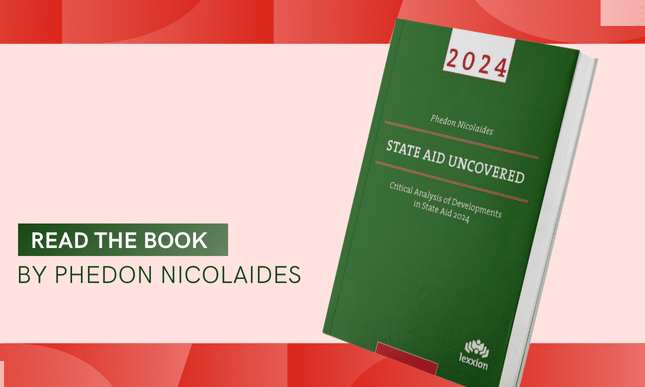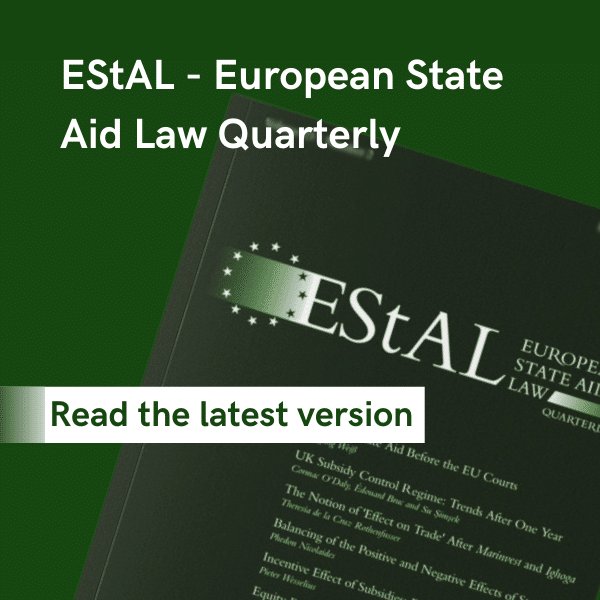
Introduction
During the covid-19 pandemic there were fewer bankruptcies than normal. The consensus opinion is that the vast amounts of liquidity that were pumped into EU economies saved not only healthy companies but also many of those that would have otherwise gone out of business.
Although the large-scale support schemes were necessary, they also created a problem: how to separate the impact of the pandemic from that of mismanagement of a company. For example, assume that a company that was teetering on the edge of bankruptcy applied for State aid to offset the damage it suffered as a result of the restrictions that were imposed by governments to prevent the spread of the virus. The standard methodology for calculating the amount of that damage is to compare, on the one hand, the actual revenue it earned minus the costs it avoided in a given period, with the hypothetical net revenue in a counterfactual situation of no covid-19, on the other. According to the standard methodology, the counterfactual is the comparable period before the outbreak of the pandemic. In most cases, it was the Spring of 2019 or the Autumn of 2019 or the whole of 2019, depending on when each Member State had ordered closures. This methodology appears credible and, in fact, it is used by the Commission and endorsed by EU courts.
But, consider another fact of the pandemic. Most of the people who died during the 2020-21 period had pre-existing health problems. Their immune system was already weak. Is it, therefore, possible that the “immune” system of a company may have been similarly weakened so that, even without the covid-19 related restrictions, its condition would have deteriorated in 2020 or 2021 in comparison to 2019? If the answer is plausibly yes, then the impact of the pandemic was smaller, the actual damage the company suffered was also smaller and, therefore, the amount of compensatory aid that it should have received should be equally smaller.
This conclusion reflects the gist of the arguments before courts in cases of claims for damage by cartel or monopolistic practices. As the judgment which is reviewed in this article demonstrates, the sophisticated methodologies used in anti-trust cases have not yet had much influence on the calculation of compensatory aid under Article 107(2)(b), which still relies to a large extent on a comparison of company performance between two periods, without any in-depth analysis of how the market and the position of the affected company would have evolved in the absence of the pandemic.
On 6 November 2024, the General Court, in case T-827/22, Whizz Air v Commission, dismissed Whizz Air’s action against Commission decision SA.63360 which had approved State aid for Romania’s state-owned TAROM airline for damage compensation.[1]
In February 2020, the Commission authorised rescue aid to TAROM [SA.56244]. In October 2020, the Commission authorised aid to TAROM based on Article 107(2)(b) TFEU, intended to compensate it for the damage suffered during the period from 16 March to 30 June 2020 [SA.56810]. In April 2022, the Commission authorised additional compensatory aid under Article 107(2)(b) for damage suffered in the period 1 July and 31 December 2020 [SA.63360]. This is the contested measure. In the meantime, Romania had notified restructuring aid to TAROM, which was approved by the Commission in April 2024 [SA.59344]. Several interventions whose effects have to be disentangled.
What damage can be compensated?
After determining that Whizz Air had legal standing to challenge the Commission decision, the General Court examined the substantive pleas. First, Whizz Air argued that the Commission made manifest errors as regards the damage eligible for compensation.
The General Court began its assessment by recalling the Commission’s methodology. “(46) In order to calculate the amount of damage suffered by TAROM on the eligible routes during the relevant period as a result of the travel restrictions linked to the COVID-19 pandemic, the Commission compared, on each of the routes in question, on the one hand, TAROM’s actual results during the relevant period and, on the other, TAROM’s results in a counterfactual scenario, without travel restrictions linked to the COVID-19 pandemic. The total amount of the damage suffered by TAROM corresponds to the difference between those two results, calculated on the basis of TAROM’s revenues and its fixed and variable costs on each of the routes concerned.”
Whizz Air argued that in establishing the counterfactual scenario, the Commission erred in using TAROM’s financial results for 2019 instead of forward-looking data, in view of TAROM’s recurring losses.
The response of the General Court was that “(50) TAROM’s actual results during the period from 1 July to 31 December 2019 on the eligible routes, which the Commission took into account in preparing the counterfactual scenario, were the most recent historical data recorded before the onset of the COVID-19 pandemic. As a general rule, it is appropriate to take into account the most recent historical data”.
This approach does not consider whether there could be a downward trend in the performance of TAROM continuing into 2020.
The General Court added that “(53) in any event, […] in spite of TAROM’s continued negative results, its annual results remained relatively consistent between 2017 and 2019.”
Please note an implicit but fundamental methodological issue here. The Court endorses the Commission’s extrapolation of historic data. Nonetheless, the essence of identifying a counterfactual situation is to isolate the effect of the pandemic by considering how the situation of TAROM would have evolved. The Commission and the Court merely assumed that in the absence of the pandemic there would have been no further deterioration of TAROM’s performance. Yet the company needed multiple amounts of aid.
The Court insisted that “(55) as regards the applicant’s assertion that the Commission did not sufficiently examine TAROM’s losses attributable to the COVID-19 pandemic in order to distinguish them from the losses attributable to its business model, it is apparent from the contested decision that the methodology used by the Romanian authorities to calculate the damage suffered by TAROM, […], takes into consideration only TAROM’s revenues and costs that were directly linked to its passenger air transport activities. Those revenues and costs had thus been directly affected by the travel restrictions linked to the COVID-19 pandemic on the routes concerned.”
This response just ignores the point raised by Whizz Air: that there could have been a decline in TAROM’s revenue and costs in the absence of travel restrictions.
Surprisingly, as shown below, the Commission did carry out some adjustments to costs by considering how certain costs would have been allocated in the absence of travel restrictions. The General Court addressed this issue in response to the Whizz Air’s claim that the method used by the Commission to allocate fixed costs significantly influenced the amount of damage suffered by TAROM.
“(60) As the Commission maintains in its pleadings, […] the damage suffered by TAROM as a result of the discontinuation or drastic reduction of the air transport services provided should include a portion of the fixed costs incurred by that company for the corresponding compensation periods during the relevant period, to which the services on the routes in question would have contributed in the absence of the exceptional occurrence which caused the travel restrictions. According to that paragraph, fixed costs may vary in the event of large variations in output, namely in the number of passengers, as is the case for TAROM, even though any variation of that type is likely to be less than proportional with respect to output. The Commission thus considered that the linear adjustment of fixed costs submitted by TAROM was consistent with the evidence of the relation between fixed costs and passenger numbers specific to TAROM, on the basis of the observation of actual fixed costs and passengers in 2019 and in 2020. That adjustment took account of the less than proportional variation in fixed costs in response to a large reduction in passenger volumes and the associated economies of scale that characterise TAROM’s business model, and also of the allocation of fixed costs on the basis of the 2019 route-by-route data.”
The adjustment described above is sensible. The question that arises is why not make similar adjustments to the revenue side. In other words, there is a logical inconsistency in the methodology of the treatment of revenue and costs.
This brings us to another important question. Who has to establish a credible counterfactual? The burden of proof surely lies on Member States. But, as already established by the Court of Justice [see, for example, its judgment in the Tempus Energy case], the Commission is also obliged, on its own initiative, to gather all the necessary information.
However, the General Court was of a different view. “(76) As regards the applicant’s argument that the Commission should have taken into account, in its examination of the counterfactual scenario, the intensification of competition between low-cost airlines, it should be pointed out, as the Commission observes, that the applicant has not quantified the losses caused to TAROM by that alleged increase in competition between low-cost airlines. That argument is therefore insufficiently substantiated and too speculative to succeed”. Shouldn’t Romania or the Commission be responsible to consider how the market would have evolved?
Whizz Air further argued that TAROM’s difficulties that led to the rescue aid were not taken into consideration in the counterfactual scenario applied by the Commission. The General Court rejected that argument because “(79) the applicant is in reality again disputing the use of TAROM’s financial results in 2019 when preparing the counterfactual scenario. However, the applicant’s assertion that after August 2020, in the absence of the COVID-19 pandemic, TAROM would have been required either to reduce the scale of its operations or change its business model is based solely on the fact that the rescue aid did not cover the period after that date. That argument is therefore speculative.”
Indeed, it is speculative. So, is the assumption that the 2019 performance would have been repeated in 2020 or 2021. Although the counterfactual scenario is speculative, it is an attempt to establish a credible alternative to the observed events. Shouldn’t the possible evolution of the market be taken into account?
Yet, later on, the General Court did endorse the Commission’s adjustment of the results of TAROM by taking into account how passenger traffic would have evolved.
“(96) The applicant observes that, in establishing the counterfactual scenario, the Commission accepted a downward adjustment of TAROM’s actual results for the period from 1 July to 31 December 2019 on the routes in question, in order to exclude passengers who would not have travelled on the eligible routes in 2020 even in the absence of travel restrictions. In order to make that adjustment, the Commission calculated what it called the ‘retention rate’, namely the number of passengers that TAROM would have retained in the counterfactual scenario, based on the number of passengers who had taken a domestic flight, not subject to travel restrictions, in 2020, expressed as a percentage of the number of passengers on domestic flights in 2019.”
This adjustment was made because more passengers travelled in the domestic routes than in international routes in 2020.
“(97) It is not disputed that the domestic routes as a whole were not affected by travel restrictions during the relevant period. The Commission, when establishing the counterfactual scenario, thus considered that TAROM would have carried on the eligible routes only 28% of the passengers it had carried on those routes during the same period in 2019.”
“(98) The calculation of the number of passengers that TAROM would have retained was based on a bundle of routes free from any travel restrictions during the whole of the relevant period, namely all domestic routes, apart from those cancelled for commercial reasons. […] domestic routes constituted a good benchmark for observing passenger behaviour on routes with no travel restrictions. In that regard, the Commission explained in the contested decision that, by comparison, international routes had been affected by travel restrictions during the relevant period and that, consequently, those routes did not constitute a good benchmark for calculating the ‘retention rate’, that is to say, the number of passengers that TAROM would have retained.”
It is appropriate that such adjustments were made. But it is on international routes that TAROM faced more competition. It is not explained in the judgment why the General Court agreed that the domestic routes provided a “good benchmark”.
Avoidance of overcompensation
Whizz Air argued that TAROM was overcompensated, allegedly because the Commission failed to take into account the rescue aid that had been granted on the basis of Article 107(3)(c).
The General Court, first, recalled that “(116) there is nothing to preclude a beneficiary of aid under Article 107(2)(b) TFEU from being an undertaking concurrently benefiting from rescue aid under Article 107(3)(c) TFEU, provided that the conditions of Article 107(2)(b) TFEU are met”.
“(117) The Commission addressed the question of the rescue aid previously granted to TAROM […] and concluded that there was no risk of cumulation with that aid.”
“(118) In that regard, it must be borne in mind that the measure at issue consists of a capital injection and is intended to compensate TAROM for the damage which it directly suffered on the eligible routes in the corresponding compensation periods during the relevant period as a result of the travel restrictions attributable to the COVID-19 pandemic.” “(119) The rescue aid, on the other hand, consists of a loan granted in February 2020, repayable after six months, and is intended to provide liquidity support for items already determined in advance (for example, the costs payable to staff and suppliers) in the liquidity plan submitted to the Commission before the COVID-19 pandemic, the costs of which were evaluated at the time of the decision on rescue aid to TAROM.” “(120) Those payments made in application of the rescue aid are not compensation. The amount of those payments constitutes a debt for TAROM and is refinanced in the restructuring plan.” “(121) In contrast, the compensation for the damage suffered by TAROM that is authorised in the contested decision covers the unforeseen losses of revenue incurred during the relevant period as a result of the travel restrictions attributable to the COVID-19 pandemic, which are not taken into account in the decision on rescue aid to TAROM or in the liquidity plan. The amount of aid granted under the measure at issue is revenue and not debt.” “(122) The payment of compensation to TAROM under the measure at issue represented a cash inflow that would reduce the costs of the restructuring of TAROM, so that that compensation would not be included in the restructuring plan and the damage caused by the travel restrictions linked to the COVID-19 pandemic would not be covered twice by aid.”
Should the advantage conferred by the aid be taken into account in preventing overcompensation?
Whizz Air argued that the Commission failed to consider the advantage obtained by TAROM as a result of the aid in finding that there was no overcompensation.
That argument was rejected by the General Court. “(130) For the purposes of assessing the compatibility of aid with the internal market, the advantage procured by that aid for its recipient does not include any economic benefit the recipient may have enjoyed as a result of exploiting that advantage”.
“(131) Thus, in the case of the measure at issue, that is to say, aid in the form of a capital injection, the amount of aid granted to TAROM, which the Commission must take into account in order to determine whether there has been any overcompensation of the damage suffered by that company as a result of the exceptional occurrence at issue, corresponds, in principle, to the injection of EUR 1,908,872 of capital. By contrast, for the purposes of that determination, the Commission must not have regard to any advantage that TAROM might have indirectly derived from the measure at issue, such as the competitive advantage alleged by the applicant.”
Conclusions
In the rest of the judgment, the General Court examined and rejected several pleas alleging infringement of the principle of non-discrimination and freedom to provide services.
This judgment does not break any new ground. But it reveals the difficulty in the calculation of compensation under Article 107(2)(b) which requires the establishment of a credible counterfactual: what would have happened had the exceptional event or natural disaster not occurred. It is not clear what issues need to be taken into account [e.g. evolution of the market or of competition] and the extent to which the Commission is obliged to ensure that the counterfactual scenario is credible in the sense that it covers all relevant and plausible issues that may affect the position of the aid recipient in the absence of the event that causes the direct damage.
[1] The full text of the judgment can be accessed at:



